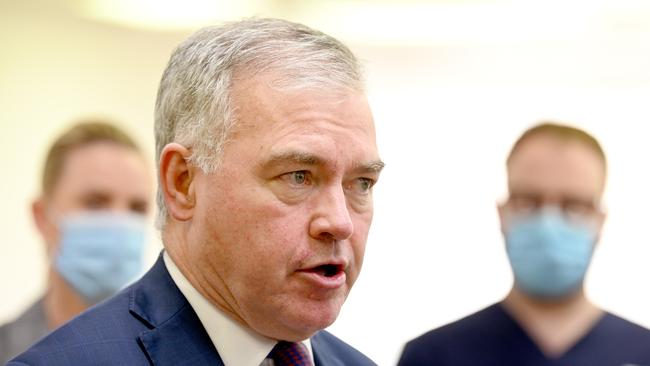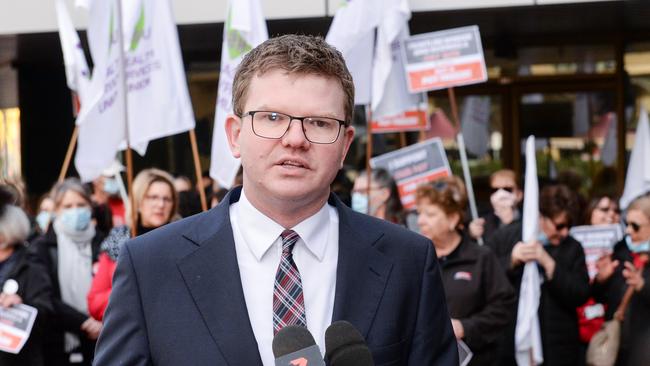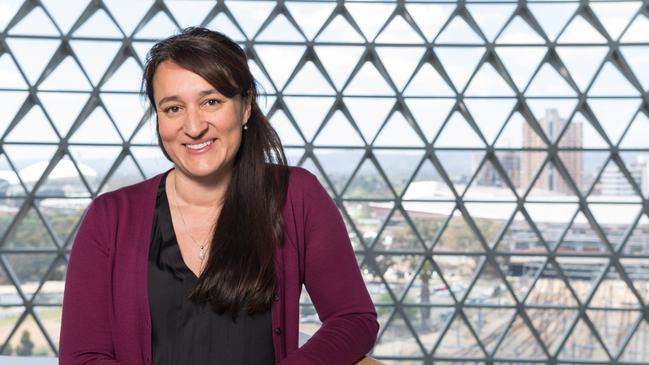A health system in crisis – but our politicians are bickering over the definition of a ‘sick kid’
As debate rages on whether the $1.95bn Women’s and Children’s Hospital is big enough, the Health Minister and his shadow are busy arguing over the definition of “sick kid”.
SA News
Don't miss out on the headlines from SA News. Followed categories will be added to My News.
What constitutes a “sick child” is at the centre of arguments over the $1.95bn new Women’s and Children’s Hospital.
Health and Wellbeing Minister Stephen Wade said opposition health spokesman Chris Picton had repeatedly stated the new hospital would have “only one extra bed for sick kids who need it”.
The numbers revolve around overnight beds, treatment spaces and recovery areas.
Government figures show there will be 11 additional overnight paediatric beds – 134 compared with 123 – in units including paediatric medical (going from 71 beds to 72), adolescent (from 18 to 20), oncology (from nine to 14) and the paediatric intensive care unit (from 13 to 16), while mental health beds stay at 12.
“What the opposition is referring to, specifically, is the number of paediatric medical beds,” Mr Wade said.
“There are currently 71 paediatric medical beds at the Women’s and Children’s Hospital. The new hospital will have 72 paediatric medical beds.
“It is incorrect to not include the other units when referring to overnight paediatric beds or overnight beds for sick kids. Are children with cancer not sick?”

WCH analysis of peaks and flows in the 71 paediatric medical beds shows occupancy has rarely exceeded 60 beds.
The government says there will be 174 paediatric overnight beds and “day treatment spaces” at the new hospital compared to 150 at the current WCH. The emergency department goes from 24 to 43 treatment spaces. In total – women and paediatric – the WCH has 441 treatment spaces while the new hospital will have 500.
“The way treatment is provided to children is evolving – changing therapies and practices mean a greater opportunity to treat patients as day patients rather than admit them for an overnight hospital stay,” Mr Wade said.
However, Mr Picton said overnight paediatric and adolescent admitted treatment spaces would fall from 199 to 198.
This included a drop in overnight beds from 36 to 24 in the paediatric surgical 23-hour unit which included recovery, with Mr Picton saying these “also arguably are sick kids”.

He called for the release of the business case for the hospital, the costs spent on consultancies, and whether the plan had gone to Infrastructure SA – which could see the $1.95bn price tag change.
“The Liberals’ own plans make clear there is only one extra paediatric medical bed, and overall there will be one less paediatric overnight bed,” Mr Picton said.
“There’s been a lot of talk about treatment spaces but very sick kids need overnight hospital beds, and the plans show in black and white there will overall be one less bed than what we have now.”
WCH Alliance spokesman Professor Warren Jones said: “SA Heath has done a snow job in not including surgical beds in their analysis, hence their figure of an increase of 11 from 123 to 134.
“However, the surgical overnight beds have decreased by 12 from 76 to 64, an overall loss of one bed. They seem not to have included surgery because they contend that it is only the medical children who are sick.
“By definition, children needing an operation have something wrong – that is, they’re sick.”
Clues to keep the elderly out of hospital
Adelaide researchers have pinpointed an ideal time to intervene to prevent older people ending up in hospital, in a move they say can unclog busy emergency departments and ease ambulance ramping.
The work, using 25 clues to predict the need for action, comes as major hospitals reel from huge demand in recent days, including:
ROYAL Adelaide Hospital and Queen Elizabeth Hospital declaring internal emergencies as demand on their EDs overwhelms staff;
THE opening of Flinders Medical Centre’s new ED as the biggest in the state fails to stop ramping, and;
DOCTORS’ and nurses’ unions declaring the Women’s and Children’s Hospital ED is in “crisis” and putting children’s safety at risk.
The University of South Australia and the South Australian Health and Medical Research Institute research shows one in five South Australians will experience an unplanned trip to hospital within 90 days of an aged-care assessment. The study analysed outcomes of 22,130 people who had an aged-care eligibility assessment (ACAT) and developed 25 predictors to identify older people most at risk of needing unplanned hospital care.
These risk factors include the level of frailty and types of medications taken.
Lead researcher Professor Maria Inacio said the findings indicated the ACAT was a promising time to start programs to reduce the need for hospital care.
“If we provide targeted treatment or therapies during this time, we cannot only provide better support to older people transitioning to care, but we could reduce overcrowding and ramping in our hospitals as well,” she said.

More than 186,000 Australians have an ACAT each year to see whether they qualify for various levels of help at home or are eligible for subsidised nursing home care.
“We can identify moderately well those most at risk of being hospitalised, meaning we can determine the older people who need the most follow up after their assessment,” Professor Inacio said.
“We found 25 specific predictors of either hospitalisations or emergency department encounters, including recent history of high use of after-hours services, prior hospitalisation, and certain medications.”
Professor Inacio, who oversees the Registry of Senior Australians national database, said the study offered practical recommendations to reduce the risk of needing hospital care.
“Older people are usually on a lot of medication, for example,” she said.
“We found that after a certain number of medications, they are at a higher risk of unplanned hospitalisations.
“Optimised medication management is one potential area that could be implemented through existing programs such as home medicine reviews.
“This is a Medicare-subsidised program for older people living in the community, yet it is not used as often as it should be.”
Professor Inacio also called for investment in services to help combat frailty such as physical exercise if possible, or comprehensive management with geriatric specialists and allied health professionals to improve the quality of life of the elderly while reducing the strain on hospitals.





